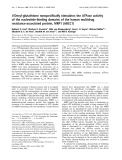
Cancers of humans
-
Objectives: Assessment of anti-human colon cancer cell (HT-29 cell) efficacy and activating apoptosis of MeV and MuV combination in vitro. Assessment of C cell tumor efficacy of MeV and MuV combination in nude mice xenograft models.
 26p
26p  petsematary
petsematary
 02-06-2021
02-06-2021
 8
8
 2
2
 Download
Download
-
Demonstrating the main chemical constituents of Anodendron paniculatum (Roxb.) A.DC. Structural determination of isolated compounds; evaluation of the cytotoxic activities of isolated compounds against human cancer cell lines.
 25p
25p  nguathienthan12
nguathienthan12
 23-05-2021
23-05-2021
 13
13
 3
3
 Download
Download
-
The objectives of the thesis: Research in the toxin/protein having bioactive isolated from Heterometrus laoticus (H. laoticus) scorpion and krait Bungarus fasciatus (B. fasciatus) snake venom.
 32p
32p  extraenglish
extraenglish
 24-05-2021
24-05-2021
 13
13
 3
3
 Download
Download
-
The objectives of the thesis: Research in the toxin/protein having bioactive isolated from Heterometrus laoticus (H. laoticus) scorpion and krait Bungarus fasciatus (B. fasciatus) snake venom.
 32p
32p  extraenglish
extraenglish
 24-05-2021
24-05-2021
 21
21
 3
3
 Download
Download
-
Single-nucleotide polymorphisms (SNP) are common genetic changes in the human genome. In recent time, many scientists have shown their interests in studies on SNPs’ roles in the pathological risk especially in cancer and metabolic diseases.
 27p
27p  tamynhan0
tamynhan0
 15-06-2020
15-06-2020
 18
18
 1
1
 Download
Download
-
Regulators of G protein signaling (RGS) proteins modulate G protein-coupled receptor (GPCR) signaling networks by terminating signals produced by active Gα subunits. RGS17, a member of the RZ subfamily of RGS proteins, is typically only expressed in appreciable amounts in the human central nervous system, but previous works have shown that RGS17 expression is selectively upregulated in a number of malignancies, including lung, breast, prostate, and hepatocellular carcinoma.
 10p
10p  caothientrangnguyen
caothientrangnguyen
 09-05-2020
09-05-2020
 13
13
 1
1
 Download
Download
-
Human immunodeficiency virus type 1 protein R (HIV-1 Vpr) promotes nuclear entry of viral nucleic acids in nondividing cells, causes G2 cell cycle arrest and is involved in cellular differentiation and cell death. Vpr subcellular localization is as variable as its functions. It is known, that consistent with its role in nuclear transport, Vpr localizes to the nuclear envelope of human cells. Further, a reported ion channel activity of Vpr is clearly dependent on its localization in or at membranes.
 6p
6p  system191
system191
 01-06-2013
01-06-2013
 33
33
 4
4
 Download
Download
-
Human glandular kallikrein 2 (hK2) is a trypsin-like serine protease expressed predominantly in the prostate epithelium. Recently, hK2 has proven to be a useful marker that can be used in combination with prostate specific antigen for screening and diagnosis of prostate cancer. The cleavage by hK2 of certain substrates in the proteolytic cascade suggest that the kallikrein may be involved in prostate cancer development; however, there has been very little other progress toward its biochemical characterization or elucidation of its true physiological role.
 8p
8p  system191
system191
 01-06-2013
01-06-2013
 45
45
 2
2
 Download
Download
-
The effect of the extracellular chaperone, clusterin, on amyloid fibril formation by lipid-free human apolipoprotein C-II (apoC-II) was investigated. Sub-stoichiometric levels of clusterin, derived from either plasma or semen, potently inhibit amyloid formation by apoC-II. Inhibition is dependent on apoC-II concentration, with more effective inhibition by clusterin observed at lower concentrations of apoC-II. The average sedimentation coefficient of apoC-II fibrils formed from apoC-II (0.3 mgÆmL)1) is reduced by coincubation with clusterin (10 lgÆmL)1). ...
 6p
6p  system191
system191
 01-06-2013
01-06-2013
 36
36
 3
3
 Download
Download
-
Group IID secretory phospholipase A2 (sPLA2-IID), a heparin-binding sPLA2 that is closely related to sPLA2-IIA, augments stimulus-induced cellular arachidonate release in a manner similar to sPLA2-IIA. Here we identified the residues of sPLA2-IID that are responsible for heparanoid binding, are and therefore essential for cellular function.
 10p
10p  system191
system191
 01-06-2013
01-06-2013
 36
36
 5
5
 Download
Download
-
Previously, we demonstrated apoptotic cell death in the chorion laeve trophoblast layer of human fetal membrane tissues during the late stages of pregnancy, the progression of apoptosis during incubation in vitro, and its suppression by a low concentration of glucocorticoid hormones.
 8p
8p  system191
system191
 01-06-2013
01-06-2013
 33
33
 5
5
 Download
Download
-
Tyrosyl-DNA phosphodiesterase (TDP) cleaves the phosphodiester bond linking the active site tyrosine residue of topoisomerase I with the 3¢ terminus of DNA in topoisomerase I–DNA complexes which accumulate during treatment of cancer with camptothecin. In yeast, TDP mutation confers a 1000-fold hypersensitivity to camptothecin in the presence of an additional mutation of RAD9 gene [Pouliot, J.J., Yao, K.C., Robertson, C.A. & Nash, H.A. (1999) Science 286, 552–555].
 8p
8p  research12
research12
 01-06-2013
01-06-2013
 34
34
 2
2
 Download
Download
-
A splicing factor SF2/ASF is a natural substrate for the kinase activity of human topoisomerase I. This study demonstrates that SF2/ASF inhibits DNA cleavage by human topoisomerase I induced by the anti-cancer agent camptothecin. The inhibition is independent of the phosphorylation status of SF2/ASF. We show that the inhibition did not result from binding of SF2/ASF to DNA that would hinder interactions between topoisomerase I and DNA. Neither it was a consequence of a loss of sensitivity of the enzyme to camptothecin.
 7p
7p  research12
research12
 01-06-2013
01-06-2013
 39
39
 5
5
 Download
Download
-
The human multidrug resistance-associated protein (MRP1) is an ATP-dependent efflux pump that transports anionic conjugates, and hydrophobic compounds in a glutathione dependent manner. Similar to the other, well-characterized multidrug transporter P-gp, MRP1 comprises two nucleotide-binding domains (NBDs) in addition to transmembrane domains. However, whereas the NBDs of P-gp have been shown to be functionally equivalent, those of MRP1 differ significantly.
 9p
9p  research12
research12
 01-06-2013
01-06-2013
 25
25
 4
4
 Download
Download
-
Thioredoxin is a ubiquitous dithiol oxidoreductase found in many organisms and involved in numerous biochemical processes. Human thioredoxin-like protein (hTRXL) is differentially expressed at different development stages of human fetal cerebrum and belongs to an expanding family of thioredoxins. We have solved the crystal structure of the recombinant N-terminal catalytic domain (hTRXL-N) of ˚ hTRXL in its oxidized form at 2.2-A resolution.
 9p
9p  research12
research12
 01-06-2013
01-06-2013
 41
41
 4
4
 Download
Download
-
Tetraalkylammonium (TAA) salts are well known reversible inhibitors of cholinesterases. However, at concentrations around 10 mM, they have been found to activate the hydrolysis of positively charged substrates, catalyzed by wild-type human butyrylcholinesterase (EC 3.1.1.8) [Erdoes, E.G., Foldes, F.F., Zsigmond, E.K., Baart, N. & Zwartz, J.A. (1958) Science 128, 92].
 8p
8p  research12
research12
 01-06-2013
01-06-2013
 31
31
 2
2
 Download
Download
-
The spermine analogue N1,N11-diethylnorspermine (DENSPM) efficiently depletes the cellular pools of putrescine, spermidine and spermine by down-regulating the activity of the polyamine biosynthetic enzymes and up-regulating the activity of the catabolic enzyme spermidine/ spermine N1-acetyltransferase (SSAT). In the breast cancer cell line L56Br-C1, treatment with 10 lM DENSPM induced SSAT activity 60 and 240-fold at 24 and 48 h after seeding, respectively, which resulted in polyamine depletion. ...
 7p
7p  research12
research12
 01-06-2013
01-06-2013
 53
53
 5
5
 Download
Download
-
Calcitonin (Ct) is a 32-residue peptide hormone that is mainly known for its hypocalcemic effect and the inhibition of bone resorption. Our previous studies have led to potent, side-chain lactam-bridged human Ct (hCt) analogues [Kapurniotu, A. Kayed, R., Taylor, J.W. & Voelter W. (1999) Eur. J. Biochem.265, 606±618; Kapurniotu, A. & Taylor, J.W. (1995)J. Med. Chem.38, 836±847]. We have hypothesized that a possibly type Ibturn/bsheet confor-mation in the region 17±21 may play an important role in hCt bioactivity. ...
 12p
12p  research12
research12
 01-06-2013
01-06-2013
 46
46
 5
5
 Download
Download
-
Matrilysin (matrix metalloproteinase-7) plays important roles in tumor progression. It was previously found that matrilysin binds to the surface of colon cancer cells to promote their metastatic potential. In this study, we identified annexin II as a novel membrane-bound substrate of matrilysin. Treatment of human colon cancer cell lines with active matrilysin released a 35 kDa annexin II form, which lacked its N-terminal region, into the culture supernatant. The release of the 35 kDa annexin II by matrilysin was significantly enhanced in the presence of serotonin or heparin....
 14p
14p  research12
research12
 29-04-2013
29-04-2013
 41
41
 2
2
 Download
Download
-
TheDrosophila melanogasterprotein sprouty is induced uponfibroblast growth factor (FGF)- andepidermal growth factor (EGF)-receptor tyrosine kinase activation and acts as an inhibitor of the ras/MAP kinase pathway downstreamof these receptors. By differential displayRT-PCRof activated vs. resting umbilical artery smooth muscle cells (SMCs) we detected a new human sprouty gene, which we designated human sprouty 4 (hspry4) based on its homology with murine sprouty 4.
 11p
11p  research12
research12
 29-04-2013
29-04-2013
 45
45
 2
2
 Download
Download
CHỦ ĐỀ BẠN MUỐN TÌM
































